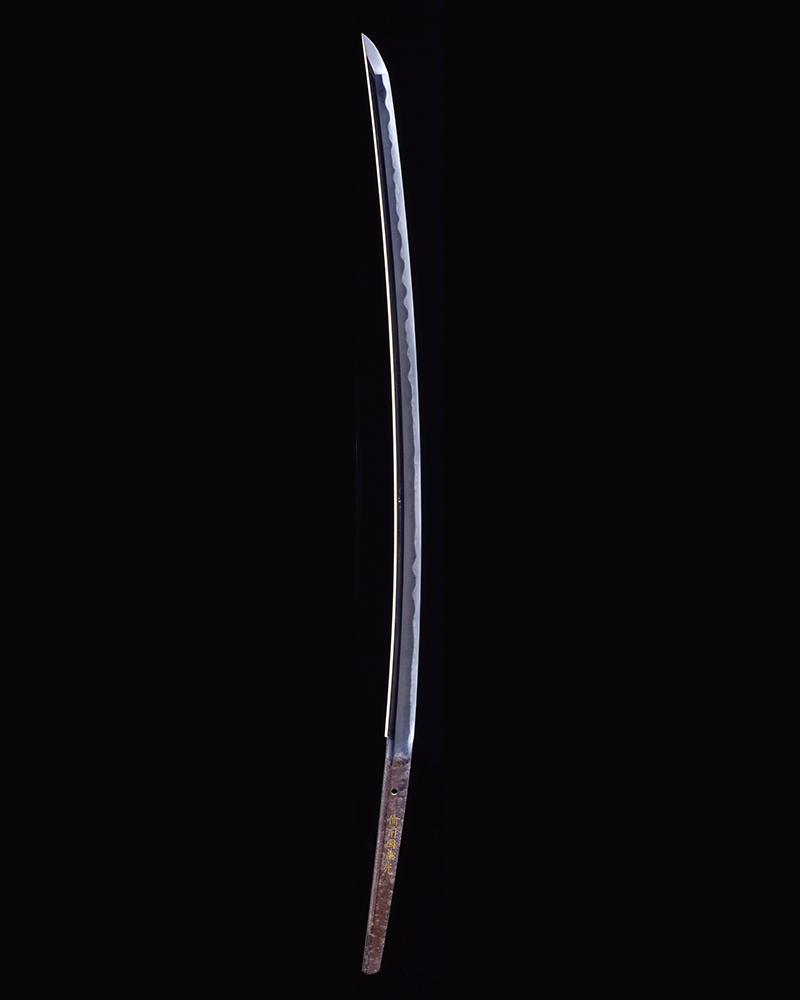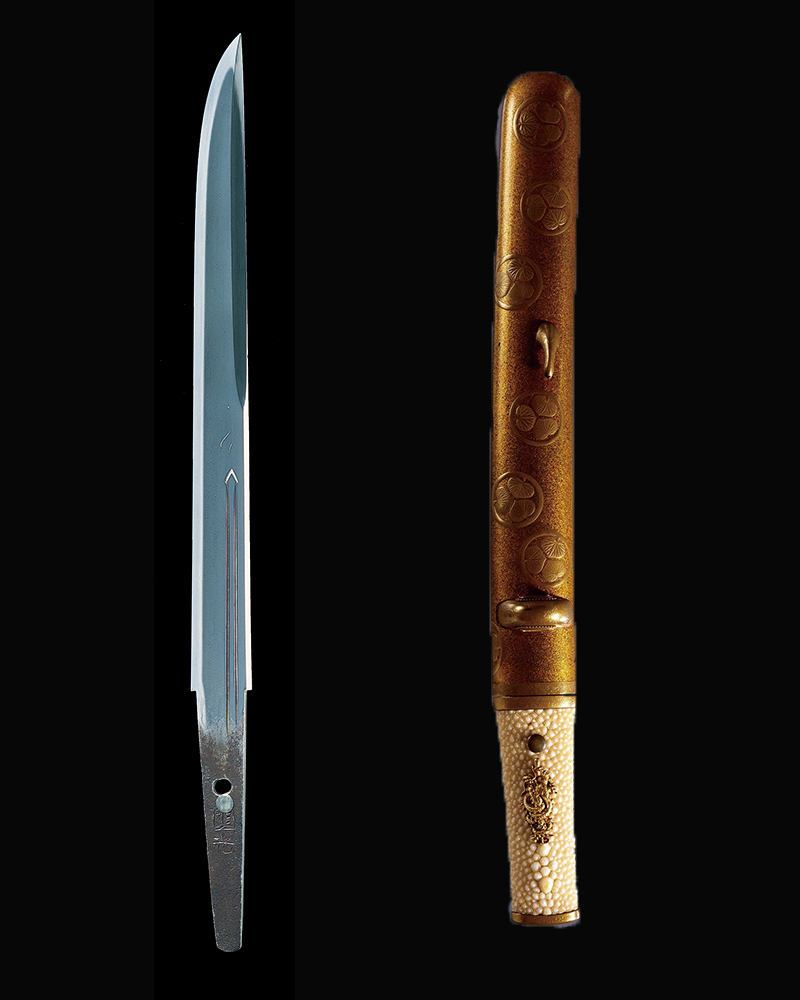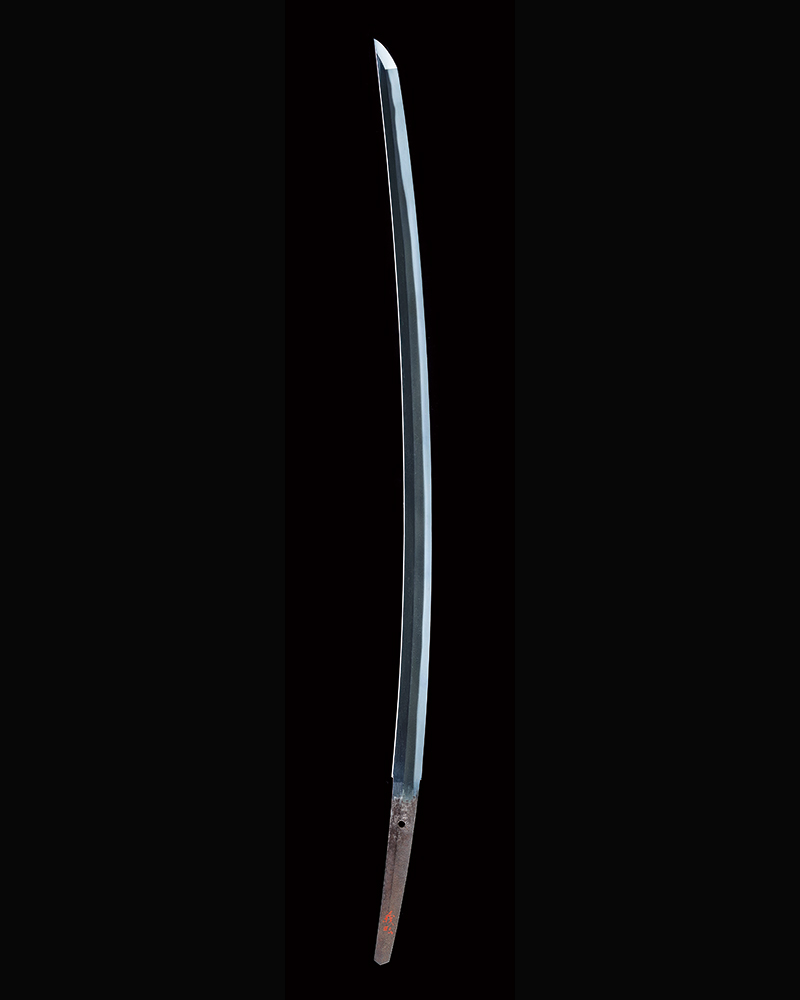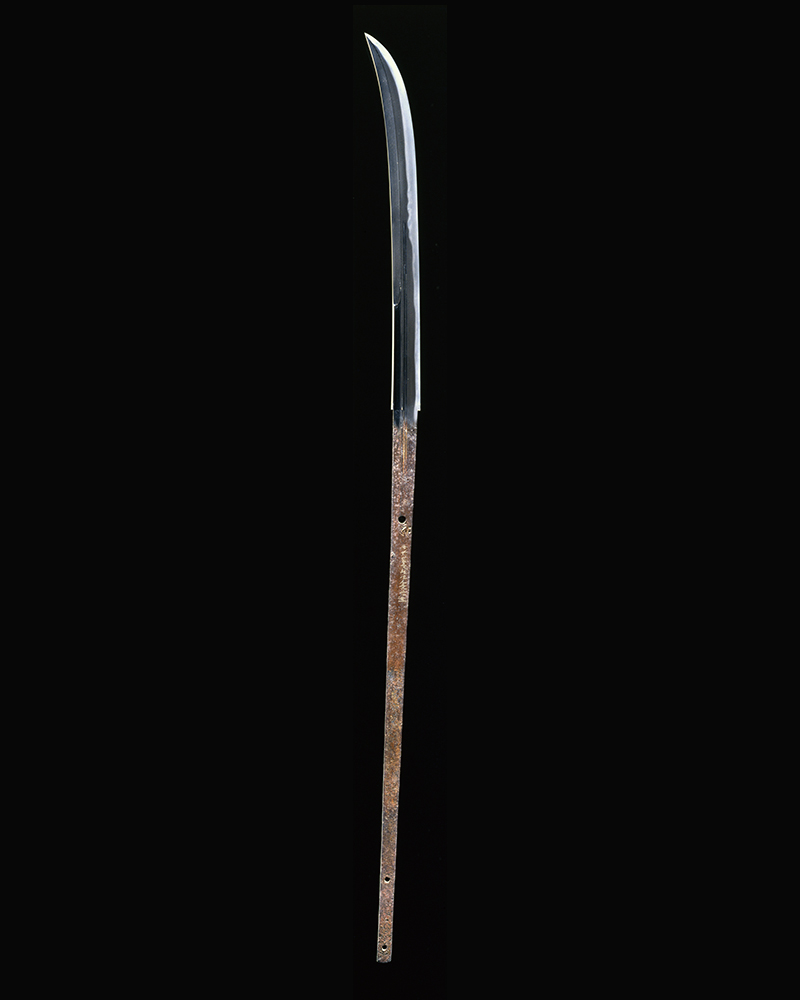Autumn grass pattern black lacquer sword mounting, contents, sword, inscribed, made by Yukihira of Bungo Province
(The Autumn Grassland Black Forest)
Specific information
Important Cultural Property
author
Sword / Yukihira from Bungo Province
Country
Japan
Era
Mounting / Muromachi period (16th century)
Tachi / Early Kamakura period (13th century)
Traits
Mounting / Thread-wrapped sword mounting
Tachi/Higashi-zukuri forging
Number of members
1 waist
Law
Mounting/Total length 122.0 cm
Tachi/Blade length 76.6 cm Curvature 3.6 cm
Commentary
The black lacquer tachi is a sword with a sheath, handle and metal fittings all painted black lacquer, and was the most commonly used sword for actual combat from the Heian to Muromachi periods. This sword has a large crescent moon designed in silver inlay on the sheath, a round iron tsuba, black shakudo metal fittings with delicate autumn grass hair engravings, and golden brown thread wrapped around the handle and watamaki. It is said to have belonged to the Sengoku warlord Uesugi Kenshin, and reflects the owner's preferences. The middle sword was made by Yukihira of Bungo Province in the early Kamakura period.
Naginata (long sword) inscribed with the name of Nagamitsuzo, a resident of Osafune, Bizen Province
(The Naginata Masterpiece: A 100-Year-Old Man from the Land of Bizen)
Specific information
National Treasure
author
Nagamitsu
Country
Japan
Era
Kamakura period (13th century)
Traits
Naginata making and forging
Number of members
1 share
Law
Blade length 44.2 cm Curvature 1.7 cm
Commentary
Nagamitsu is a swordsmith from Osafune, Bizen Province (present-day Okayama Prefecture) who represents the Kamakura period. The son of Mitsutada, the founder of the Osafune school, Nagamitsu was active as the head of a large workshop and is the swordsmith of his time with the most surviving swords bearing his signature. His style is diverse, ranging from the gorgeous clove pattern similar to that of his father to the more subtle pattern of the Gunome pattern.
Naginata were expendable items used in actual combat from the Kamakura to Muromachi periods, so it is extremely rare to find one in such good condition. It was handed down to the Matsudaira family of Tsuyama. It was donated by Sato Kanji in 1988.
Sword with gold inlay, Kanemitsu from Bizen Province/Honami (signature) (famous item: Okanemitsu)
(The Golden Age of the Golden Age of the Golden Age / The Golden Age of the Golden Age)

Specific information
Important Cultural Property
author
Kanemitsu
Country
Japan
Era
The Northern and Southern Courts Period (14th century)
Traits
Shinogi Forging
Number of members
1 share
Law
Blade length 83.5 cm Curvature 2.3 cm
Commentary
Kanemitsu was the fourth master of the Osafune clan and a master swordsmith representing the Nanboku-cho period. His early style was similar to that of his father Kagemitsu, with kataochi tsuname and chojiba blades, but around the Enbun period (1356-1360) his style changed and he started to make large tachi with a large blade and Kamakura-style nodaremon (dragging patterns). This work is typical of his later period, and although it is a long sword with a blade length of over one meter, the exquisite jigane is seamlessly engraved with a tranquil nodaremon (dragging patterns) that is different from the Kamakura style, demonstrating his high level of skill. It was later polished and features gold inlay by Hon'ami Koun. It was bestowed by Todo Takatora at the residence of Maeda Toshitsune as a relic of Toyotomi Hideyoshi, and was later passed down to the Tokugawa Shogunate.
Short sword, inscribed Kunimitsu, with gold pear ground and hollyhock crest lacquer work
(Tanto famous country three)
(Golden stalk green tea leaf making)

Specific information
Important Cultural Property
author
Kunimitsu (Go Shindo)
Country
Japan
Era
Short sword / Kamakura period (13th century)
Mounting / Edo period
Traits
Short sword/kanmuri-otoshi forging
Mounting / Gold-lacquered, jointed mounting
Number of members
1 waist
Law
Short sword / Blade length 25.1 cm Curved
Mounting/Total length 38.9 cm
Commentary
The blade is made with a refined, carefully crafted Kanmuri-Otoshi-zukuri style, and the straight blade is tempered with a sense of tension. This is a famous sword that represents the master of the short sword, Shintogo Kunimitsu. Kunimitsu is the de facto founder of the Kamakura school, which is dated to 1293. He is said to have been the master of the master craftsman Masamune, and is considered to be of the Awataguchi school in Kyoto. This short sword is full of charm, with the beautiful shine of the boiling on the finely grained jigane from the Awataguchi style, the round boiling on the blade, and the dancing gold lines inside the blade. The accompanying aiguchi-koshirae, without a tsuba, was made in the late Edo period, and has a gold pear-ground hollyhock-crested lacquer scabbard, a Kurikara-ryu kozuka, and menuki by the 15th generation of the famous metalworker Goto Mitsumi. It was originally a sword stored in the possession of Hosokawa Moritate (1883-1970).
Sword Unsigned Masamune
(Masamune Katana)

Specific information
Important Cultural Property
author
Masamune
Country
Japan
Era
Kamakura period (14th century)
Traits
Shinogi Forging
Number of members
1 share
Law
Blade length 68.2 cm Curvature 2.7 cm
Commentary
Masamune was a disciple of Shintogo Kunimitsu, and was a swordsmith active in the late Kamakura period. He created a new style of swordsmithing that emphasized the beautiful jigane and was full of dynamism, and had a great influence on later swordsmiths. Many of the swords that have been passed down as Masamune's works are o-matsuage, and this sword is one of them. The clear, blue jigane has a loose, taremon pattern that is said to have been created by Masamune. The edge of the blade shows a scene that has been praised as "snow disappearance," with the nioi overlaid with nioi, and the gold lines in the blade, the ground scenery, and other woven nioi patterns shine, making this a work of tranquility yet dynamic beauty. It was presented as a relic of Todo Takahisa, and was bestowed upon Tokugawa Yoshimune of Kii, who later gave it to him as a gift for the recovery of a young lord from smallpox. Since then, it has been used for similar celebratory occasions for generations.
Sword, inscribed in red with Yoshihiro/Hon'a (signature) (famous Matsuie)
(Katana Shumei Yoshihiro / Hona (Kao) Masterpiece Matsuigou)

Specific information
Important Cultural Property
author
Yoshihiro
Country
Japan
Era
Kamakura period (14th century)
Traits
Shinogi Forging
Number of members
1 share
Law
Blade length 69.4 cm Curvature 1.6 cm
Commentary
Yoshihiro is a master swordsmith from Matsukura-go, Ecchu, who is said to have been of the same school as Masamune. No swords bearing his signature remain to this day, and very few have been handed down, but an inscribed tang is featured in the Muromachi period sword book "Oseki Sho," and Yoshihiro has been known as a master swordsmith since then. This sword has an extremely finely grained and exquisite jigane, and a straight blade. The blade shines with clear, round boiling, making it a brilliant masterpiece. It is listed in the "Kyoho Meibutsu-cho," and is known as "Matsuie" because it was owned by Matsui Sado-no-kami, a retainer of the Hosokawa clan, lord of the Kumamoto domain. It was given as a gift to Tsuruhime, daughter of the fifth Tokugawa shogun, Tsunayoshi, when she married into the Kishu Tokugawa clan, and has been passed down in the family ever since. The red inscription on the tang is by Hon'ami Mitsutsune.












